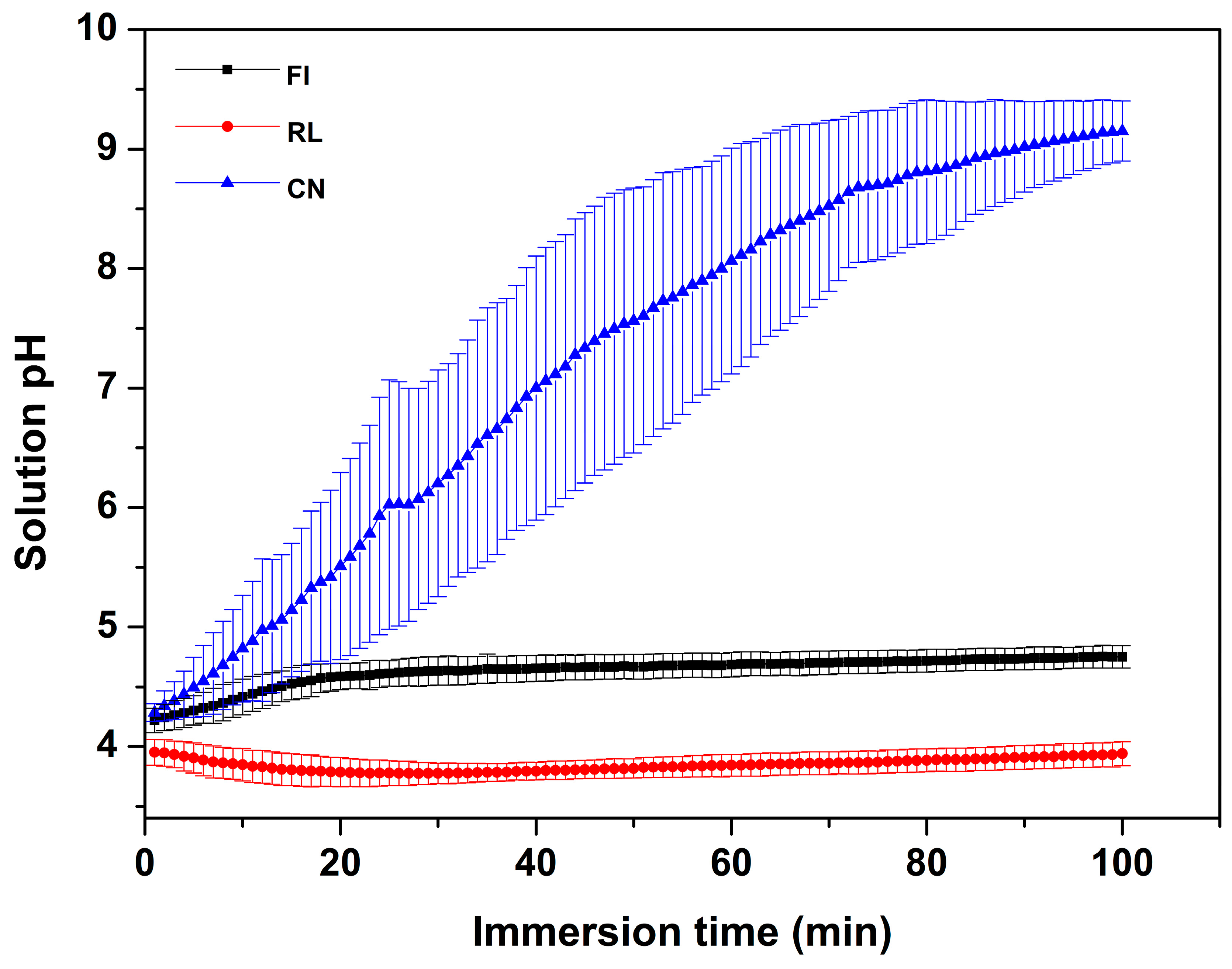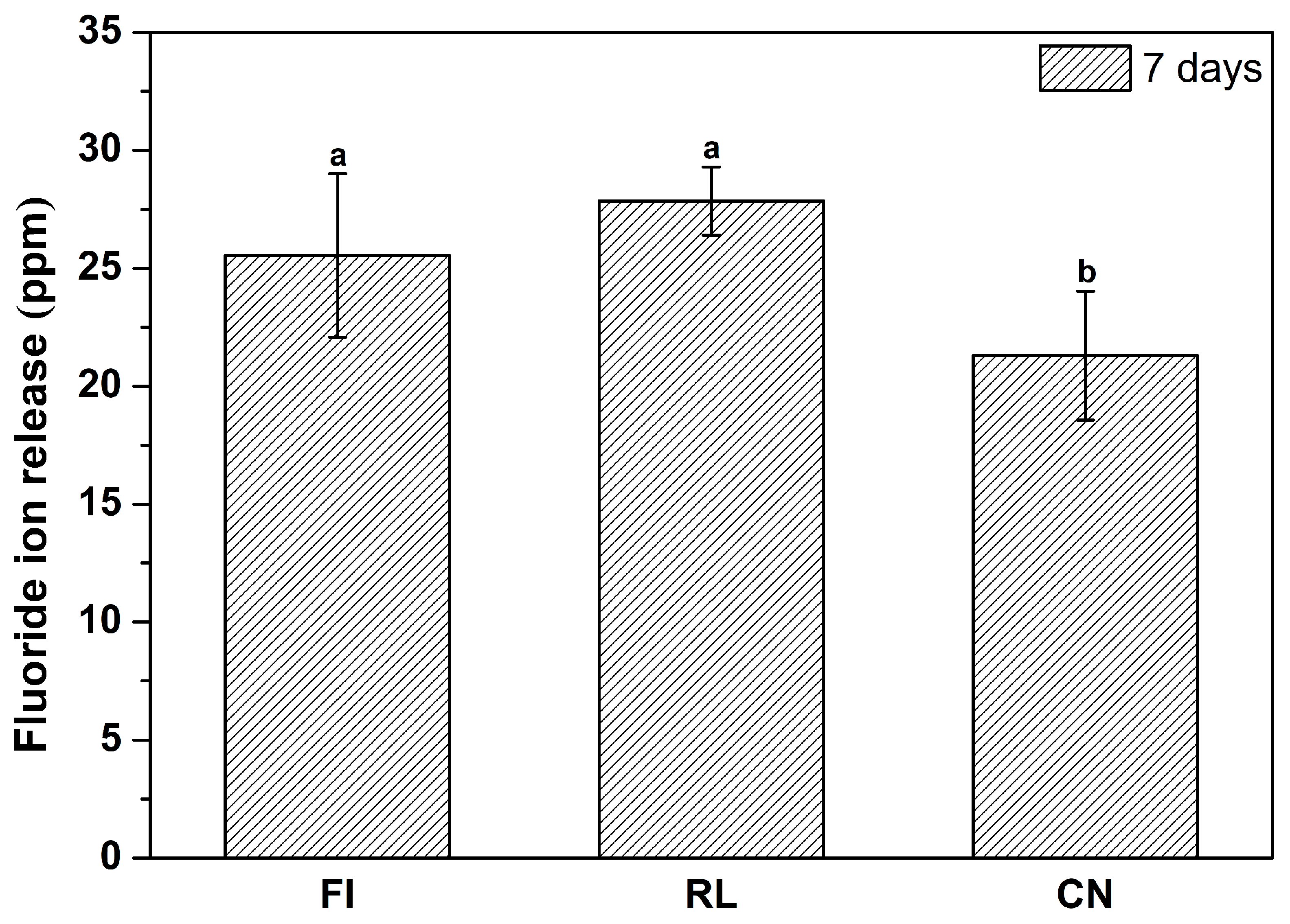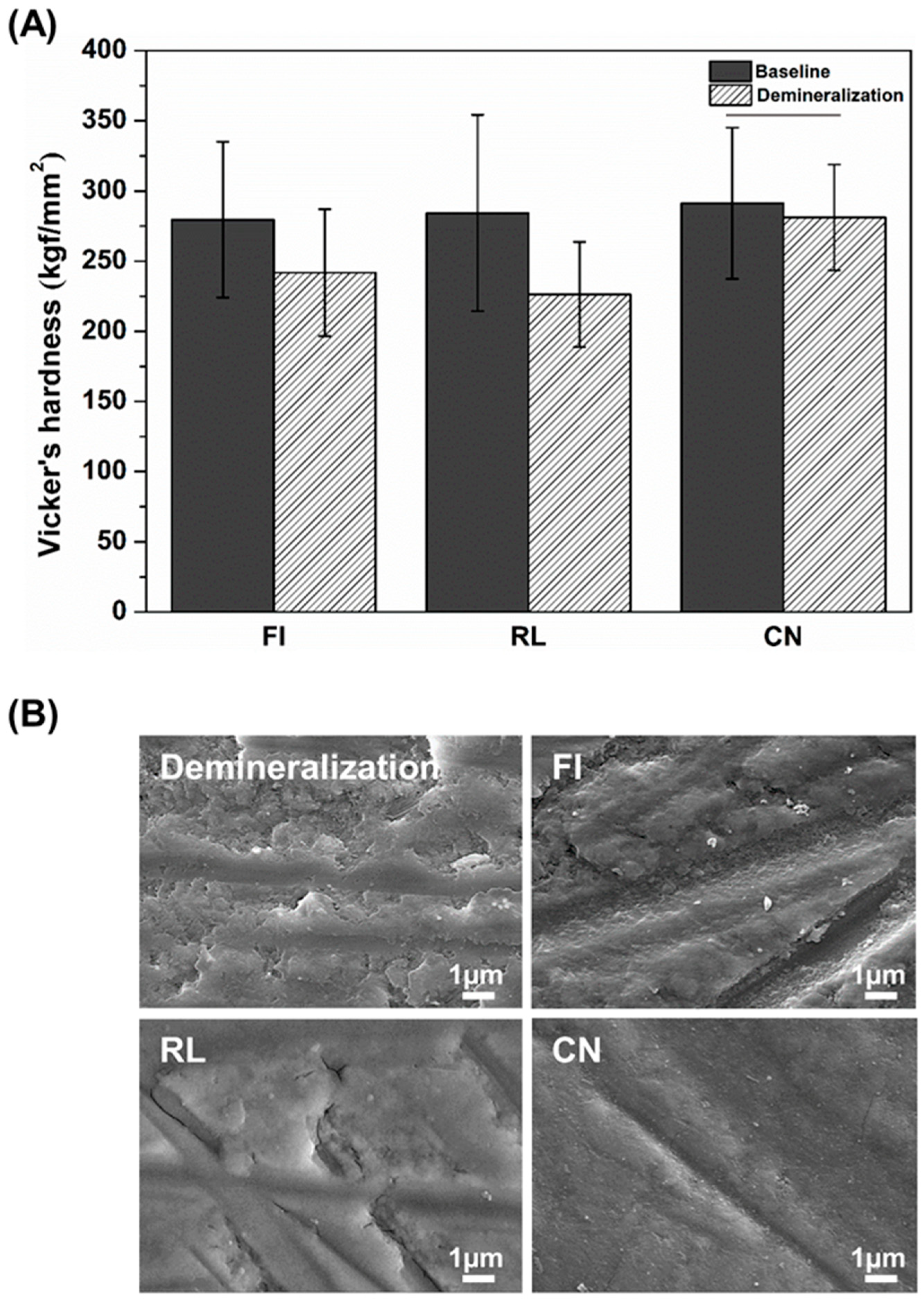Enamel Demineralization Resistance and Remineralization by Various Fluoride-Releasing Dental Restorative Materials
Abstract
:1. Introduction
2. Materials and Methods
2.1. Materials
2.2. Scanning Electron Microscopy (SEM) Observation of Materials’ Surfaces
2.3. Acid Neutralization Property
2.4. Fluoride Ion Release
2.5. Calcium Concentration
2.6. Demineralization Resistance Test
2.7. Remineralization Test
2.8. Statistical Analysis
3. Results
3.1. Scanning Electron Microscopy (SEM) Images of the Materials’ Surfaces
3.2. Acid Neutralizing Property
3.3. Fluoride Ion Release
3.4. Calcium Concentration
3.5. Demineralization Resistance Test
3.6. Remineralization Test
4. Discussion
5. Conclusions
Author Contributions
Funding
Institutional Review Board Statement
Informed Consent Statement
Data Availability Statement
Conflicts of Interest
References
- Koldehoff, J.; Schneider, G.A. Effect of deproteinization treatments on the structure and mechanical properties of dental enamel. Materialia 2021, 16, 101088. [Google Scholar] [CrossRef]
- Yang, S.-Y.; Piao, Y.-Z.; Kim, S.-M.; Lee, Y.-K.; Kim, K.-N.; Kim, K.-M. Acid neutralizing, mechanical and physical properties of pit and fissure sealants containing melt-derived 45s5 bioactive glass. Dent. Mater. 2013, 29, 1228–1235. [Google Scholar] [CrossRef]
- Tiskaya, M.; Al-Eesa, N.; Wong, F.; Hill, R. Characterization of the bioactivity of two commercial composites. Dent. Mater. 2019, 35, 1757–1768. [Google Scholar] [CrossRef] [PubMed]
- Al-Qarni, F.; Weir, M.; Melo, M.A.; Al-Dulaijan, Y.; Almulhim, K.S.; Xu, H.H. Novel calcium phosphate ion-rechargeable and antibacterial adhesive to inhibit dental caries. Clin. Oral Investig. 2021, 1–11. [Google Scholar] [CrossRef]
- Simeonov, M.; Gussiyska, A.; Mironova, J.; Nikolova, D.; Apostolov, A.; Sezanova, K.; Dyulgerova, E.; Vassileva, E. Novel hybrid chitosan/calcium phosphates microgels for remineralization of demineralized enamel—A model study. Eur. Polym. J. 2019, 119, 14–21. [Google Scholar] [CrossRef]
- Clift, F. Artificial methods for the remineralization of hydroxyapatite in enamel. Mater. Today Chem. 2021, 21, 100498. [Google Scholar] [CrossRef]
- Ramadoss, R.; Padmanaban, R.; Subramanian, B. Role of bioglass in enamel remineralization: Existing strategies and future prospects—A narrative review. J. Biomed. Mater. Res. Part B Appl. Biomater. 2021, 1–22. [Google Scholar]
- Gao, Y.; Liang, K.; Weir, M.D.; Gao, J.; Imazato, S.; Tay, F.R.; Lynch, C.D.; Oates, T.W.; Li, J.; Xu, H.H. Enamel remineralization via poly (amido amine) and adhesive resin containing calcium phosphate nanoparticles. J. Dent. 2020, 92, 103262. [Google Scholar] [CrossRef]
- Bueno, L.S.; Silva, R.M.; Magalhães, A.P.R.; Navarro, M.F.L.; Pascotto, R.C.; Buzalaf, M.A.; Nicholson, J.W.; Sidhu, S.K.; Borges, A.F.S. Positive correlation between fluoride release and acid erosion of restorative glass-ionomer cements. Dent. Mater. 2019, 35, 135–143. [Google Scholar] [CrossRef]
- Kumari, P.D.; Khijmatgar, S.; Chowdhury, A.; Lynch, E.; Chowdhury, C.R. Factors influencing fluoride release in atraumatic restorative treatment (art) materials: A review. J. Oral Biol. Craniofac. Res. 2019, 9, 315–320. [Google Scholar] [CrossRef]
- Abbasi, R.; Nodehi, A.; Atai, M. Synthesis of poly (acrylic-co-itaconic acid) through precipitation photopolymerization for glass-ionomer cements: Characterization and properties of the cements. Dent. Mater. 2020, 36, e169–e183. [Google Scholar] [CrossRef] [PubMed]
- Sidhu, S.K.; Nicholson, J.W. A review of glass-ionomer cements for clinical dentistry. J. Funct. Biomater. 2016, 7, 16. [Google Scholar] [CrossRef] [PubMed]
- Alatawi, R.A.; Elsayed, N.H.; Mohamed, W.S. Influence of hydroxyapatite nanoparticles on the properties of glass ionomer cement. J. Mater. Res. Technol. 2019, 8, 344–349. [Google Scholar] [CrossRef]
- Nicholson, J.W.; Czarnecka, B. The biocompatibility of resin-modified glass-ionomer cements for dentistry. Dent. Mater. 2008, 24, 1702–1708. [Google Scholar] [CrossRef]
- Irie, M.; Nagaoka, N.; Yamashiro, T.; Suzuki, K. Mechanical properties of a resin-modified glass ionomer cement for luting: Effect of adding spherical silica filler. Dent. Mater. J. 2010, 29, 253–261. [Google Scholar]
- Naz, F.; Khan, A.S.; Kader, M.A.; Al Gelban, L.O.S.; Mousa, N.M.A.; Asiri, R.S.H.; Hakeem, A.S. Comparative evaluation of mechanical and physical properties of a new bulk-fill alkasite with conventional restorative materials. Saudi Dent. J. 2020. [Google Scholar] [CrossRef]
- Dawes, C. What is the critical ph and why does a tooth dissolve in acid? J. Can. Dent. Assoc. 2003, 69, 722–725. [Google Scholar]
- Rankine, C.; Moreno, E.; Vogel, G.; Margolis, H. Micro-analytical determination of ph, calcium, and phosphate in plaque fluid. J. Dent. Res. 1985, 64, 1275–1280. [Google Scholar] [CrossRef]
- Par, M.; Gubler, A.; Attin, T.; Tarle, Z.; Tauböck, T.T. Anti-demineralizing protective effects on enamel identified in experimental and commercial restorative materials with functional fillers. Sci. Rep. 2021, 11, 11806. [Google Scholar] [CrossRef] [PubMed]
- Ahn, J.-H.; Kim, J.-W.; Yoon, Y.-M.; Lee, N.-Y.; Lee, S.-H.; Jih, M.-K. Time-dependent anti-demineralization effect of silver diamine fluoride. Children 2020, 7, 251. [Google Scholar] [CrossRef]
- Cuy, J.L.; Mann, A.B.; Livi, K.J.; Teaford, M.F.; Weihs, T.P. Nanoindentation mapping of the mechanical properties of human molar tooth enamel. Arch. Oral Biol. 2002, 47, 281–291. [Google Scholar] [CrossRef]
- Barbour, M.E.; Parker, D.M.; Allen, G.C.; Jandt, K.D. Human enamel dissolution in citric acid as a function of ph in the range 2.30 ≤ ph ≤ 6.30—A nanoindentation study. Eur. J. Oral Sci. 2003, 111, 258–262. [Google Scholar] [CrossRef]
- Maia, A.C.; Mangabeira, A.; Vieira, R.; de Almeida Neves, A.; Lopes, R.T.; Pires, T.M.; Viana, G.M.; Cabral, L.M.; Cavalcante, L.M.; Portela, M.B. Experimental composites containing quaternary ammonium methacrylates reduce demineralization at enamel-restoration margins after cariogenic challenge. Dent. Mater. 2019, 35, e175–e183. [Google Scholar] [CrossRef] [PubMed]
- Weir, M.; Chow, L.; Xu, H.H. Remineralization of demineralized enamel via calcium phosphate nanocomposite. J. Dent. Res. 2012, 91, 979–984. [Google Scholar] [CrossRef] [PubMed] [Green Version]
- Cury, J.; Francisco, S.; Simões, G.; Cury, A.D.B.; Tabchoury, C. Effect of a calcium carbonate-based dentifrice on enamel demineralization in situ. Caries Res. 2003, 37, 194–199. [Google Scholar] [CrossRef] [PubMed]
- Yeh, S.-T.; Wang, H.-T.; Liao, H.-Y.; Su, S.-L.; Chang, C.-C.; Kao, H.-C.; Lee, B.-S. The roughness, microhardness, and surface analysis of nanocomposites after application of topical fluoride gels. Dent. Mater. 2011, 27, 187–196. [Google Scholar] [CrossRef]
- Di Hipólito, V.; de Goes, M.F.; Carrilho, M.; Chan, D.C.; Daronch, M.; Sinhoreti, M.A.C. Sem evaluation of contemporary self-etching primers applied to ground and unground enamel. J. Adhes. Dent. 2005, 7, 203–211. [Google Scholar] [PubMed]
- Kim, M.J.; Lee, S.H.; Lee, N.Y.; Lee, I.H. Evaluation of the effect of pva tape supplemented with 2.26% fluoride on enamel demineralization using microhardness assessment and scanning electron microscopy: In vitro study. Arch. Oral Biol. 2013, 58, 160–166. [Google Scholar] [CrossRef]
- Langhorst, S.; O’donnell, J.; Skrtic, D. In vitro remineralization of enamel by polymeric amorphous calcium phosphate composite: Quantitative microradiographic study. Dent. Mater. 2009, 25, 884–891. [Google Scholar] [CrossRef] [Green Version]
- Khalid, H.; Aleesa, N.; Grosjean, M.; Hill, R.; Wong, F. Characterisation of a bioactive SiO2-CaO-CaF2-Na2O glass used in composites. Dent. Mater. 2021, 37, 1–9. [Google Scholar] [CrossRef]
- Ionta, F.Q.; Mendonça, F.L.; de Oliveira, G.C.; de Alencar, C.R.B.; Honório, H.M.; Magalhaes, A.C.; Rios, D. In vitro assessment of artificial saliva formulations on initial enamel erosion remineralization. J. Dent. 2014, 42, 175–179. [Google Scholar] [CrossRef] [PubMed]
- Shen, P.; Walker, G.D.; Yuan, Y.; Reynolds, C.; Stanton, D.P.; Fernando, J.R.; Reynolds, E.C. Importance of bioavailable calcium in fluoride dentifrices for enamel remineralization. J. Dent. 2018, 78, 59–64. [Google Scholar] [CrossRef] [PubMed]





| Cord | Product | Manufacturer | Type | Composition |
|---|---|---|---|---|
| FI | Fuji IX | GC Co, Tokyo, Japan | Glass-ionomer cement | Alumino-fluoro-silicate glass polyacrylic acid, distilled water |
| RL | Riva Light Cure | SDI Limited, Bayswater, Victoria, Australia | Resin-modified glass-ionomer cement | Fluoro-alumino-silicate glass polyacrylic acid, tartaric acid, HEMA, camphorquinone |
| CN | Cention N | Ivoclar Vivadent, Schaan, Liechtenstein | Alkasite restorative
material | Calcium fluorosilicate glass, Ba-Al silicate glass, Ca-Ba-Al fluorosilicate glass, ytterbium trifluoride, isofiller UDMA, DCP, aromatic aliphatic-UDMA |
| Material | Calcium Ion Concentration (ppm) | ||
|---|---|---|---|
| 7 Days (Mean ± SD) | 15 Days (Mean ± SD) | 30 Days (Mean ± SD) | |
| FI | 0.20 ± 0.01 Aa | 0.18 ± 0.06 Aa | 0.19 ± 0.05 Aa |
| RL | 0.30 ± 0.12 Aa | 0.24 ± 0.07 Aa | 0.25 ± 0.05 Aa |
| CN | 32.51 ± 4.88 Ab | 32.32 ± 5.68 Ab | 34.06 ± 3.60 Ab |
Publisher’s Note: MDPI stays neutral with regard to jurisdictional claims in published maps and institutional affiliations. |
© 2021 by the authors. Licensee MDPI, Basel, Switzerland. This article is an open access article distributed under the terms and conditions of the Creative Commons Attribution (CC BY) license (https://creativecommons.org/licenses/by/4.0/).
Share and Cite
Kim, M.-J.; Lee, M.-J.; Kim, K.-M.; Yang, S.-Y.; Seo, J.-Y.; Choi, S.-H.; Kwon, J.-S. Enamel Demineralization Resistance and Remineralization by Various Fluoride-Releasing Dental Restorative Materials. Materials 2021, 14, 4554. https://doi.org/10.3390/ma14164554
Kim M-J, Lee M-J, Kim K-M, Yang S-Y, Seo J-Y, Choi S-H, Kwon J-S. Enamel Demineralization Resistance and Remineralization by Various Fluoride-Releasing Dental Restorative Materials. Materials. 2021; 14(16):4554. https://doi.org/10.3390/ma14164554
Chicago/Turabian StyleKim, Min-Ji, Myung-Jin Lee, Kwang-Mahn Kim, Song-Yi Yang, Ji-Young Seo, Sung-Hwan Choi, and Jae-Sung Kwon. 2021. "Enamel Demineralization Resistance and Remineralization by Various Fluoride-Releasing Dental Restorative Materials" Materials 14, no. 16: 4554. https://doi.org/10.3390/ma14164554
APA StyleKim, M.-J., Lee, M.-J., Kim, K.-M., Yang, S.-Y., Seo, J.-Y., Choi, S.-H., & Kwon, J.-S. (2021). Enamel Demineralization Resistance and Remineralization by Various Fluoride-Releasing Dental Restorative Materials. Materials, 14(16), 4554. https://doi.org/10.3390/ma14164554








